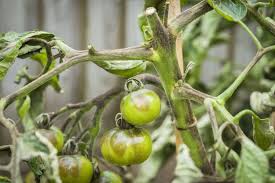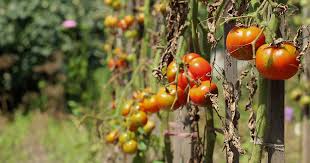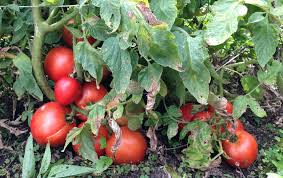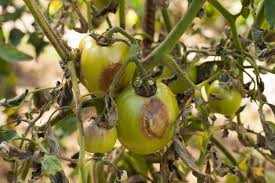Bacterial spot is caused by several species of Xanthomonas, with the most common being X. euvesicatoria (Jones et al. 2004), formerly known as X. axonopodis pv. vesicatoria or X. campestris pv. vesicatoria.
This pathogen is a motile, strictly aerobic, gram-negative rod with a single polar flagellum. On nutrient agar, single colonies appear circular, wet, shiny, and yellow after two days of incubation at 30˚C (Plate 27). Several races exist; some affect both pepper and tomato, while others are host-specific.
Symptoms of Tomato Bacterial Spot and Diagnostic Features
The pathogen affects all above-ground tomato parts including stems, leaves, and fruit (Plate 28). Leaf lesions are small (less than 3 mm), brown, circular, with water-soaked margins. These lesions can be mistaken for early blight, gray leaf spot, or target spot.
Unlike early blight caused by Alternaria solani, bacterial spot lesions lack concentric rings and are generally darker and less uniformly distributed than gray leaf spot.
Under optimal conditions, lesions may merge to form dark streaks or blighting. Defoliation due to bacterial spot is uncommon. Fruit lesions begin as raised blisters and develop into brown, scab-like, sunken areas.
Read Also: Description of Some Popular Goat Breeds
Disease Cycle and Epidemiology of Tomato Bacterial Spot

The pathogen survives on volunteer plants and infected plant debris. Seeds can serve as a source for survival and spread. Dissemination also occurs through rain splash, transplant clipping, and aerosols.
Optimal conditions for disease development are temperatures between 24-30˚C combined with heavy rainfall or prolonged dew.
Control Measures for Managing Tomato Bacterial Spot
1. Crop rotation to prevent inoculum carryover on volunteer plants and debris.
2. Use of pathogen-free seeds and transplants.
3. Seed treatment by soaking in diluted Chlorox (1% sodium hypochlorite) for 5 minutes.
4. Application of copper or copper+maneb sprays.
5. Utilization of resistant tomato cultivars, although resistance may vary against different strains.
Tomato Bacterial Wilt: Pathogen Identification and Disease Symptoms

Ralstonia solanacearum (also known as Burkholderia solanacearum or Pseudomonas solanacearum) is a gram-negative, motile rod with one or more polar flagella and aerobic metabolism. On tetrazolium chloride medium (TTC), a differential medium, large fluidal colonies with pink or red centers are visible after 48 hours at 30°C (Plate 29b).
This pathogen is a species complex with wide variation in host range (race grouping), carbohydrate utilization (biovar grouping), aggressiveness, and genetic fingerprinting.
Typical Symptoms of Tomato Bacterial Wilt
Early symptoms include drooping of a few young leaves, followed by sudden complete wilting, with leaves often remaining green at wilting onset (Plate 29a). Adventitious roots and leaf epinasty are more noticeable when the disease develops slowly or on resistant varieties (Plate 29e).
The vascular system of infected stems turns brown and darkens as the disease progresses (Plate 29c). Wilting can also result from fungal pathogens, root-knot nematodes, or excessive soil moisture.
To confirm bacterial wilt, placing a cut stem section from a wilted plant in water allows milky bacterial streams to emerge from xylem within 3 to 5 minutes (Plates 29d and 29f).
Read Also: Description of Some Popular Goat Breeds
Disease Cycle and Epidemiology of Tomato Bacterial Wilt

R. solanacearum affects over 200 cultivated species and weeds. The pathogen can colonize many weed species without visible symptoms, enhancing its survival in soil.
Survival duration depends on environmental conditions; poorly drained soils, moderate to high temperatures, and low to moderate pH favor its persistence.
The bacterium enters hosts through natural root wounds, transplanting wounds, or wounds caused by insects and nematodes.
Disease development is favored by high temperature (30-35˚C) and high soil moisture. The bacterium returns to soil via decaying infected plant parts and spreads through water, soil movement, or infected transplants.
Control Measures for Managing Tomato Bacterial Wilt
1. Use pathogen-free seedbeds and fumigate seedbeds; pasteurize potting mixtures to produce clean transplants.
2. Rotate with non-host crops, especially paddy.
3. Plant resistant tomato varieties, noting that resistance may vary by location.
4. Use resistant tomato or eggplant rootstocks to increase resistance of grafted scion varieties.
Do you have any questions, suggestions, or contributions? If so, please feel free to use the comment box below to share your thoughts. We also encourage you to kindly share this information with others who might benefit from it. Since we can’t reach everyone at once, we truly appreciate your help in spreading the word. Thank you so much for your support and for sharing!

